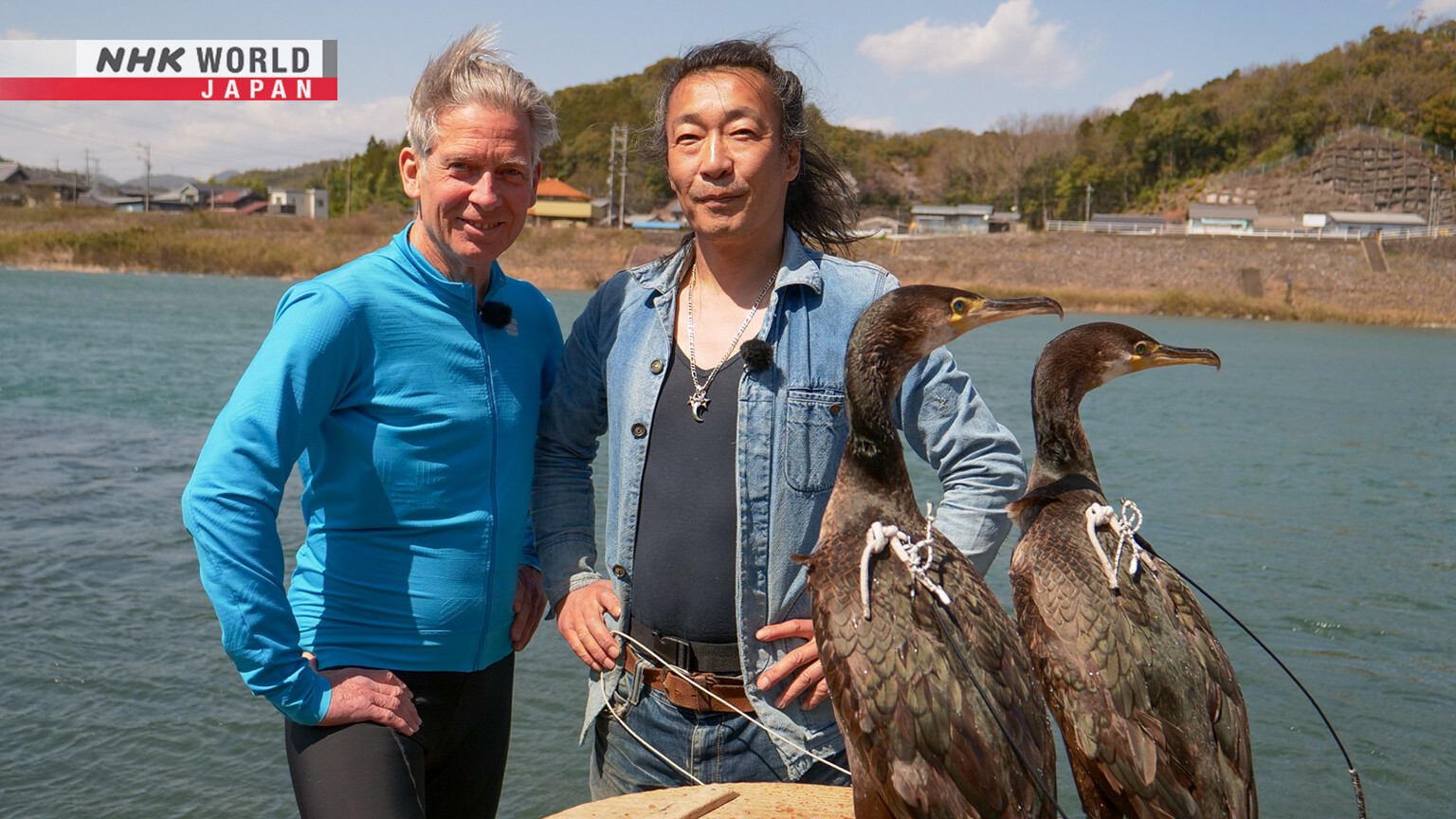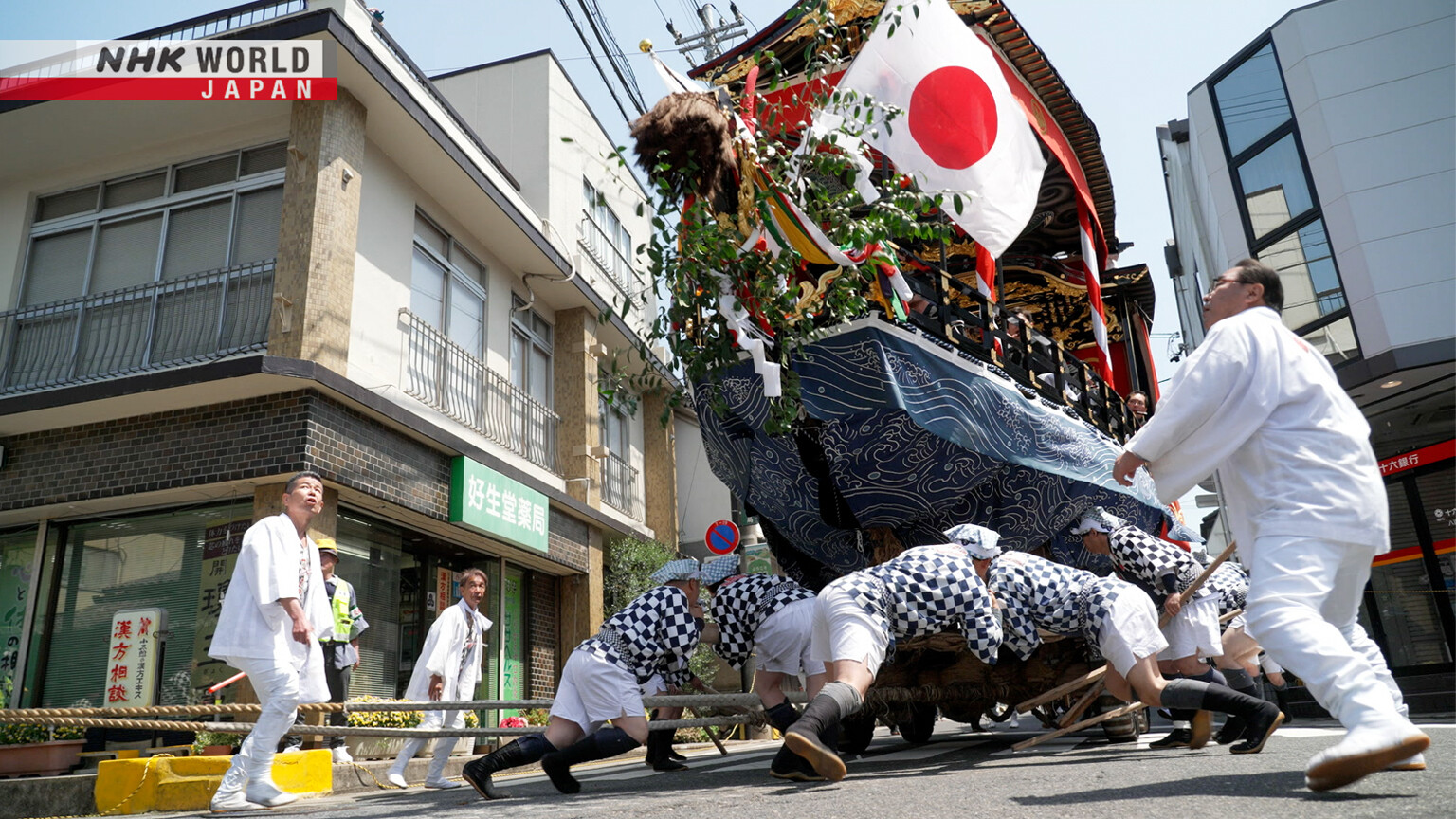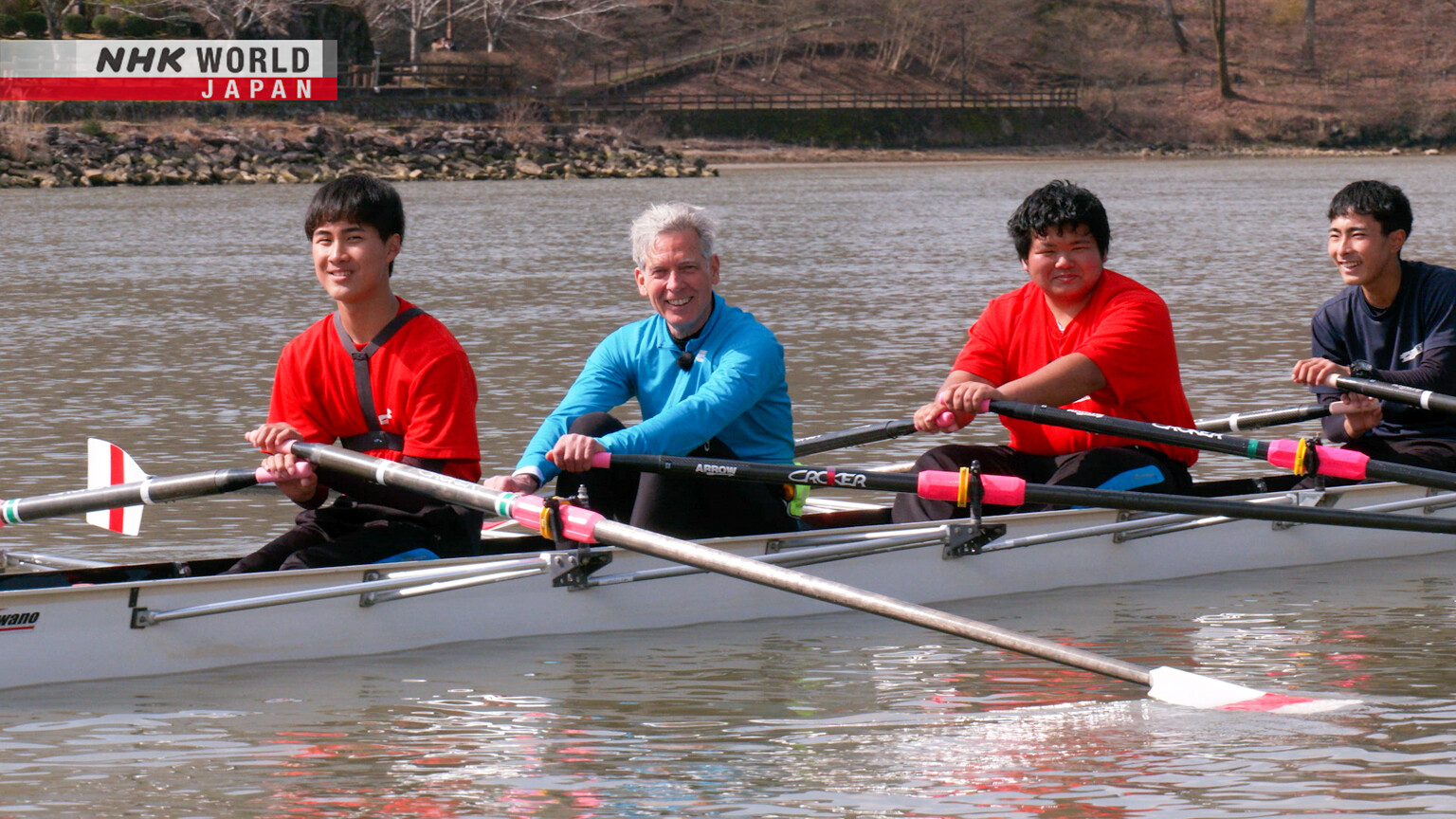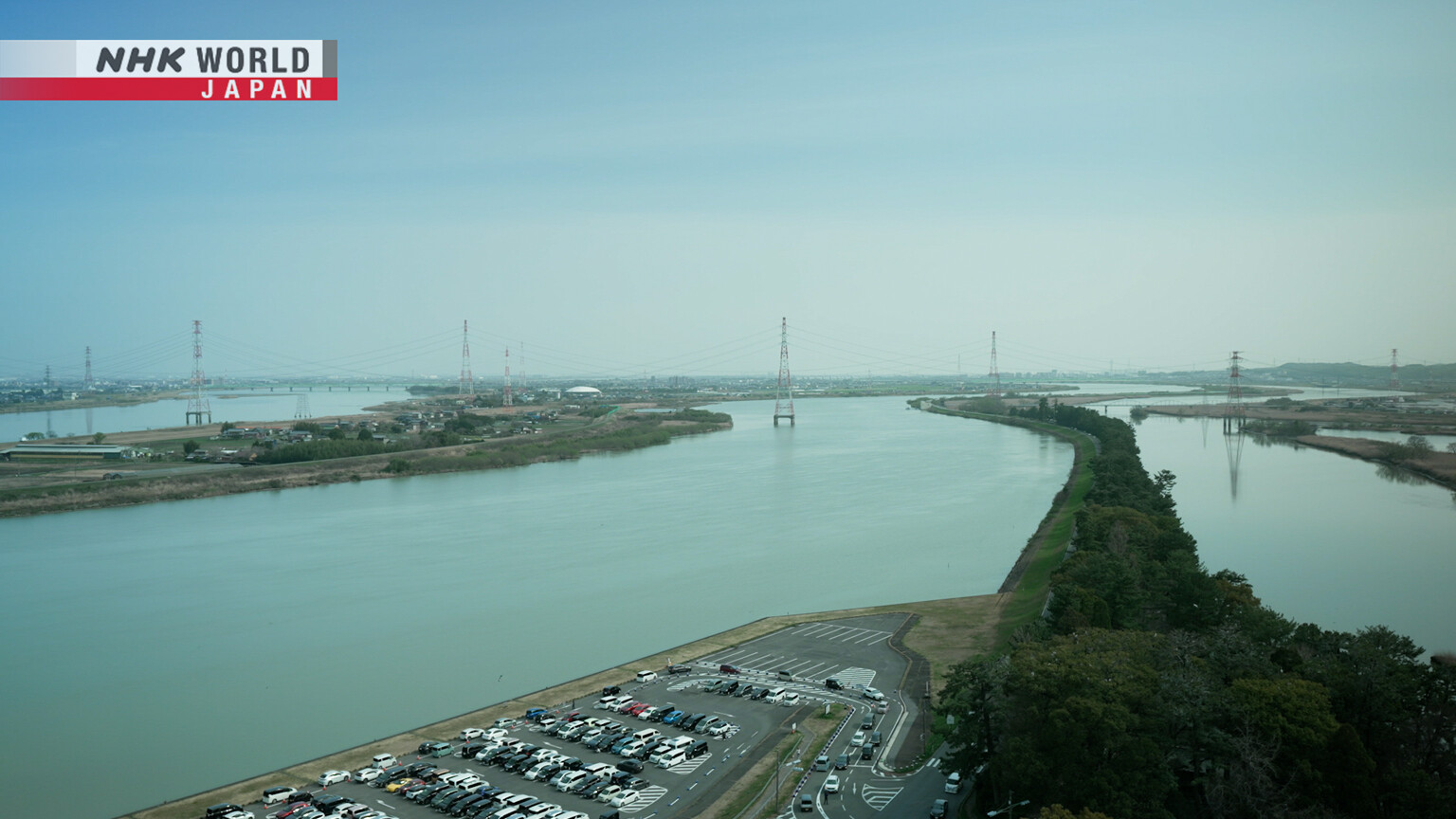Kiso Three Rivers - Going with the Flow
Our cyclist travels three large rivers in central Japan: the Kiso, the Nagara and the Ibi. He explores unique cultures related to the rivers, like cormorant fishing and an exciting float festival.




Transcript
The best way to discover little-known sights and make even familiar places feel brand new,
is to go exploring by bicycle.
Today, we're cycling around three great rivers in central Japan: the Kiso, the Nagara, and the Ibi.
Some 2 million people live in this river region.
In their basins, we'll meet people who live in harmony with the water.
Amazing power.
And we'll enjoy a festival in a sailors' town,
filled with residents passionate about handing down their traditions to future generations.
I want it to keep going for 100 or 200 years. Just as it is, in all its beauty.
It's a four-day, 300-kilometer trip following the flow of these majestic rivers.
Let's go with the flow!
It's late March.
Here, at the estuary where the three rivers merge, we meet our cyclist.
It's Paul again.
Our cyclist is Paul Imperatrice from New Zealand.
For many years, he ran an English-language school, but this spring, he kicked off his second career as a cycling tour guide.
I've taught English for 37 years, and this is the beginning of my new life.
So, I'm really looking forward to an adventure that sort of breaks the mold of how I behave.
Let's hope this is the first day of spring, and the weather stays good for us.
Let's go.
Paul's journey will take four days.
On day one, he'll ride north, following the river.
On day two, he'll head for Yaotsu, a town in the Kiso's central basin.
On the third day, he'll journey through a farming region.
On the final day, he'll follow the Kiso to its source, his final stop.
To start, he'll ride downstream from where the three rivers meet.
So I'm right in the middle of these two rivers.
The wind is pretty strong.
But it's nice to be down on the water level.
A pine forest appears on the river's edge.
It was planted some 300 years ago on this bank, created to help control flooding.
This is great.
A little bit of shade from the wind.
A bit of shade from the sun.
Very cool.
Beautiful old houses and they're wedged right up along this riverbank.
There's a lot of flooding downstream, so living by the river here is not without risk.
Alongside the Nagara runs a roughly 130-kilometer-long road perfect for cycling.
Paul enters the city of Seki.
Nagara River.
Wow, some rapids.
Paul notices someone by the river.
I think I'll go down and check him out.
- Hello.
- Hi there.
- What are you up to?
- These are cormorants.
It takes time to get them ready to fish. I put them on leashes to train them.
This is cormorant fisher Adachi Yoichiro.
The history of cormorant fishing goes back thirteen-hundred years.
Bonfires are lit to frighten sweetfish, which the cormorants then catch.
This work is so special that cormorant fishers are designated employees of the Imperial Household.
- Want to try?
- It's like I'm fishing!
- They look happy.
- Yes, I think so.
Adachi shows Paul his home, where he raises the birds.
This home was built about 300 years ago.
It's got some bug bites, but it's still standing strong.
He currently has 16 cormorants.
There's a very strong smell of animals.
Their necks stretch quite a bit. That's how they swallow fish.
You grab them by the neck. Is that okay?
It helps them relax, like when a cat purrs.
Every morning, he removes the birds from their cages
and checks them by hand one by one for any changes in their physical condition.
Very busy.
I'm surprised. I thought they would be more defensive.
But obviously this is their home.
Adachi is the 18th generation of his family to raise cormorants.
He's been living alongside these birds since his early years.
It's more like I belong to them. I take care of them 365 days a year.
Normal people are able to take trips and such.
But I haven't been on a family vacation since I was a kid! I have to take care of them.
Cormorant fishing involves making many traditional tools.
Here's one of them, a koshimino.
A koshimino is a skirt made of rice straw.
They have long been used to protect fishers from sparks of fire and splashes of water.
The roots are quite tough, so we soften them with a mallet.
Such a deep art.
You've got to make 365 of these. Think you can do it?
Paul gives it a try.
Right! Then grab it like this.
From right to left.
- Mine's not quite there yet.
- But not bad at all.
Adachi treats Paul to some sweetfish caught on the Nagara.
- Salt-grilled sweetfish with rice porridge.
- Wow, looks great.
Wow, delicious. Very very nice.
Next, sweetfish rice porridge, a local specialty.
I love this flavor.
The river is clean, and the fish eat the algae on the rocks.
They become infused with the flavor and aroma of the river.
If it gets polluted, that affects their flavor. We need to protect the river.
In recent years, environmental changes have meant fewer fish,
and cormorant fishing is now more for sightseeing than fishing.
Even so, Adachi is committed to the traditional, time-consuming methods of old.
If we don't hold on to the old ways, we'll lose our Japanese tradition and history.
That'd be a shame for future generations. I just want to keep it going as something worthwhile.
At the same time, there is no point in forcing it to continue.
Hard work is its own reward. Not to mention, it's fun.
I don't think many people are suited to this kind of work, though!
Doing one's best even when the future is uncertain: that's Adachi's philosophy.
On day two of his journey, Paul follows a tributary of the Kiso upstream.
I found this little promenade running next to the river, and the sakura are just starting to bloom, which is nice.
Very pretty.
I've now rejoined the Kisogawa, and it's sort of like a milky green color.
Big rocks, really nice flow, very clean, mountain backdrop.
Paul enters the town of Yaotsu, a place which has long flourished by the banks of the Kiso.
Wow, there's a shrine ahead, and they've got the "nobori" hanging out.
Those big flags with the bamboo poles.
Quite a gathering of people.
This local shrine is preparing for a festival.
Excuse me. What's that there?
- Any guesses?
- Hm, I'm not sure.
This is a danjiri for the Yaotsu festival. It's a kind of vehicle in the shape of a boat.
The Yaotsu Danjiri festival was founded over 300 years ago,
when Yaotsu flourished via water transportation, to pray for the safety of the river.
Each of the town's districts brings one of three danjiri, which, when combined, form the shape of a boat.
This is festival coordinator Mizuno Shinji.
Today, two weeks before the day of the festival, he's helping assemble the danjiri.
We just tied on this vine rope.
Wow, that's strong.
- All made of wood, with no nails?
- That's right, no nails.
The use of vine rope ties into the history of this river town.
In the past, logs were cut upstream, then floated to Yaotsu on rafts, where they were untied and sold as lumber.
The use of vine ropes is thought to be a remnant of the raft-tying techniques of old.
Make it so these are in opposite directions.
Wow, it's nice and tight.
Preparing for the festival takes nearly a whole year.
Three months before the main event, they meet up every week to work on the danjiri.
Harder!
This is so fun. Preparing for the festival as a team like this.
Hey, why the standard Japanese today?
I always talk like this. Stop teasing me!
Many young people who've left the town for school or work return for the festival season.
The elders teach them how it's done, passing the tradition from generation to generation.
Mizuno's son Gaku is participating in the festival for the first time in nearly a decade.
There were some years where I was busy with other things, so I left for a while.
But the more time passed, the more I wanted to join in again.
They've been prepping for about eight hours, since morning.
It's finally time for a test run of their assembled danjiri.
Due to the danger involved, they're as tense as during the actual festival.
Paul is given special permission to join in.
The biggest stars of the danjiri are the young people who maneuver it from below.
It's a dangerous job, not to be taken lightly.
The elders support the young people, giving them directions on how to move.
We're here to keep the festival alive.
I want it to keep going for 100 or 200 years. Just as it is, in all its beauty.
That's my wish, which I work hard to achieve. And I plan to continue.
I ended up yelling out, too.
Even though I'm not a local, I really got into it.
Everyone works as one, right? It's an exciting feeling.
Here in Yaotsu, these festival boats will continue to carry the hopes and dreams of the people.
A very nice early morning here and I'm getting up a little bit higher into the mountains.
It's beautiful.
Today, Paul's headed for the wide farmlands found to the south of the Kiso.
Completely clear water you can see through.
And these valleys are really cold.
Once over the mountains, Paul enters the pastoral landscape of Iwamura.
I'm really enjoying the sunshine after the chill of those mountains.
What is that?
Hello.
I've never seen anything like this. What is it?
It's hoso-kanten, a kind of kanten agar. It's used in Japanese sweets.
Hoso-kanten is made by boiling seaweed, hardening it into a jelly-like consistency,
then freezing and drying it repeatedly to remove the moisture.
It's mainly used to make wagashi: traditional Japanese sweets.
Originally, it's... I brought this batch out this morning.
- It's quite hard.
- Yeah, indeed. Wow.
Every day, we thaw, freeze, and thaw over and over to make it this light.
- It's like rice crackers. So light.
- Right, so crispy.
It's the same principle as freeze drying. Taking out the moisture.
This is second-generation kanten maker Mizuno Motoaki.
This is really heavy.
You look at it and you think, "Oh yeah I might be able to pick it up," but it's quite a serious lift.
You wouldn't want to carry that around all day.
- We make 120 of these a day.
- All by hand?
- That's right.
- Incredible.
Kanten has been made here for about a century.
Because of the mountains, it has large temperature swings between day and night,
making it perfect for kanten production.
Mizuno waits for sunny days with calm winds, then dries his kanten in the open air for two weeks.
At the peak of production in winter, it's hard to keep up even with all hands on deck.
Wow, look at this water.
This is well water, from 80 m below ground.
In the olden days, kanten makers were always located by the riverside.
The process uses a lot of water, which they took from the river to make kanten.
Huge amounts of water are used to wash and boil seaweed.
They say the quality of the kanten depends on the quality of the water.
- This process is called tentsuki.
- Tentsuki?
Tentsuki refers to the step where hardened kanten is shaped into five-millimeter square bars.
It takes a lot of strength.
- Hold it like this.
- Whoa, pretty heavy!
Pull back while holding the rod in place.
Here it comes.
This time push just a bit.
Grab it tight and place it here, then pull.
Boy, this is tiring. You need strength.
As a reward for his efforts, Paul will be treated to some homemade kanten dishes.
At the center of the table is kanten.
In the Mizuno household, kanten is part of every dish.
The consistency, it's sort of like a soft, soft jelly, but it keeps its shape like a hard noodle.
Since Mizuno took over from his father, climate change has contributed to increasingly warmer winters,
and freezing kanten outdoors has become more difficult.
There were once 100 kanten makers in this area - now, there are only eight.
The family is not sure what the future holds for their children.
Our second son is in fourth grade now.
When he was in nursery school, he suddenly told me he wanted to make kanten.
He said he needed to keep making great kanten for everyone to enjoy.
But now that he's in fourth grade, I wonder if his feelings have changed.
I'm too afraid to ask!
It's an industry that's totally dependent on the whims of the weather.
I can't change things. I have to go with the flow of the climate.
I'll let the kids do whatever they want.
But if they do want to keep it going, I need to keep things ready for them.
I want to keep it going as long as I can.
As nature changes around them, the story of this dedicated family continues.
Paul moves north through the city of Ena, headed for Ena Gorge, located in the middle reaches of the Kiso.
It's really big.
There's a group here Paul wants to meet.
I've heard there's a boat club out here so I've come to have a look.
Oh, this looks like part of it.
Hello.
Wow, you guys look professional.
- May I join in?
- Sure.
- Good morning.
- Hi there.
You're all so young.
This is Ena High School's rowing club.
Almost no one in the club had any experience with rowing until they entered high school.
But thanks to lots of hard training, they've won at nationals six times.
Some of the club's former members have even gone on to compete in the Olympic games.
There are various events in competitive rowing.
On the team, each member has a specific role.
The person in third position matches the person ahead of them and rows strongly.
- So you're the power. What about #2?
- Also power.
- And #4?
- Also power.
Paul gets special permission to join in.
He's never been rowing before.
Wow, you can definitely feel you're floating.
The balance feels a bit sensitive at the moment.
Here we go.
Wow, that's very smooth.
Keeping the rhythm is key.
Look at the person ahead of you and match their movements.
On your mark, get set, row!
- You all right?
- Yeah.
This is intense stuff.
It tires your brain more than your body!
If you don't concentrate, you're in trouble.
Amazing power!
With a bit of practice, Paul starts to get in sync with the other rowers.
Very nice. We're really cruising.
Nice work. I bet you're tired.
My hands hurt a bit at the end.
Yes, you get blisters at first. You keep getting new ones, and they become calluses.
- Mine are so thick I can't tell if things are hot or cold!
- That's funny.
It's inconvenient when drinking things.
What's the best part about rowing?
The sound, like when the oars hit the water.
It feels so good when we're in sync.
You can really feel that your efforts are helping make the boat move faster.
The Ena High School rowing club was founded over 60 years ago,
and has been passed down for generations here in the Ena Gorge.
Teacher Natsume Tatsuya is a former member of the club.
He, too, first encountered rowing in high school.
He kept rowing in university, where he studied teaching to return to his old high school as rowing club manager.
I have such strong memories of my youth.
It feels so comfortable for me here, and reminds me of those old times.
It's like looking at an old photo album.
At one point, it looked like declining membership might doom the club.
But the members got together to promote it by helping out on gorge preservation efforts and hands-on workshops for kids.
I'd be so sad if the club closed down.
I couldn't bear to think that this might be the last group of kids to participate.
So I wanted to think about ways to keep it going into the future.
Thanks to those efforts, the club was able to keep going.
This spring, in concert with the local municipality, they started a youth rowing club,
expanding the scope of rowing in this area.
The club sends Paul off with their traditional cheer.
It's Paul's last day.
He's heading for a lake near the wellspring of the Kiso.
That's very turbulent water.
Amazing.
This stretch features a rise in elevation of 600 meters.
Woah, with that wind, I feel like I've just ridden back into winter.
I think you can probably see how cold it is here.
I've been riding for four days, and I'm still riding next to the river.
It's a long one.
As you can see, there's ice and snow around.
The sun's reaching those other hills but not down here.
Whew!
Here at the end, a long final climb.
This is hardly a climb, but I've hardly got any strength left in my legs.
It's making hard work of it.
Wow, the snow caps down there.
Woah.
I think this might be it.
Made it.
Wow, that's beautiful.
The waters of the surrounding mountains flow into this lake, then into the Kiso River.
And just silent.
Suddenly the clouds have pulled back, and we have a winter scene. Look at that.
That's spectacular.
Traveling up this river has been really amazing.
As all the people I've met on the river live very close to the river and to nature itself,
these changes of climate have made life more difficult for them.
However, they haven't let this adjust their approach to life.
Whether this continues into the future or it comes to a halt,
they are fully able to accept these conditions as they all know that they can't stop the natural flow of nature.
Personally, I can relate very much to them myself.
I've gone through the same uncertainty of the future.
I think we all face this.
But most important in these uncertain times is that we stay true to our own beliefs and hope for a better future.
On this trip, Paul met people who believe that just as rivers flow out to the sea,
it's important to keep moving forward.
A reminder to believe in one's self - and go with the flow.